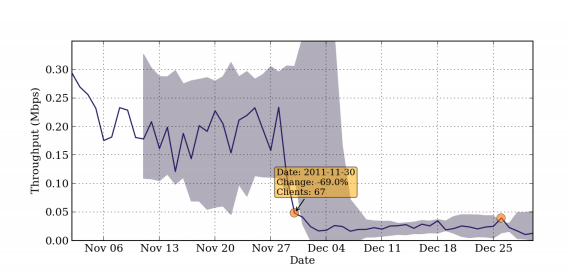First Evidence Of Iranian Internet Throttling as a Form of Censorship
One of the growing concerns for human rights campaigners is the increasing evidence of internet censorship in many repressive regimes around the world. During the Arab spring, for example, Egyptian leaders “switched off” the internet in an attempt to prevent activists organising protests or communicating with the outside world. The Syrian leadership appears to have done a similar thing on several occasions during the current civil war.

But in Iran, the government is pioneering a more insidious but just as powerful form of censorship. Instead of shutting down internet access, the government appears to be dramatically slowing its performance during periods of unrest. In February 2010, for example, the technology news website, The Next Web, recorded this effect in a story with the headline : “The Internet In Iran Is Crawling, Conveniently, Right Before Planned Protests”.
So-called internet throttling has numerous advantages over a complete shutdown since it constrains protests while allowing vital communications to continue. It is also difficult to distinguish from ordinary disruptions. The result is that throttling is much less likely to lead to widespread condemnation.
An interesting question is how to detect internet throttling when it occurs. Today, the internet security expert, Collin Anderson, shows how publicly-available data clearly reveals suspicious periods of internet slowing in Iran and how this can be distinguished from ordinary slowing caused by high traffic, equipment failure and so on.
The data that makes this possible comes from the Measurement Lab, a non-partisan organisation that distributes open software for measuring internet performance. M-Lab has developed a widely used network diagnostic tool that measures performance by sending a ten second burst of data as fast as possible through a newly opened connection.
Since 2009, M-Lab has conducted some 200,000 connection tests per day, collecting over 700 Terabytes of data in the process. This is data from all over the world and is publicly available for anybody study.
Anderson’s analysis focuses on the data gathered from Iran since 2010. He says the results clearly show evidence of internet slowing on several occasions. “We find two significant and extended periods of potential throttling within our dataset, occuring November 30 2011- August 15 2012 and October 4 - November 22 2012,” he says. During the first of these periods, download throughput dropped by 77 per cent and in the second it dropped by 69 per cent.
Both of these occasions coincide with periods of unrest in Iran. During the winter of 2011, for example, two former presidential candidates were held under house arrest because of their reformist activities, triggering condemnation within Iran. In October 2012, there were widespread currency protests.
In addition, Anderson says there are another eight or nine shorter periods during which internet performance slows suspiciously.
An important task is to distinguish periods of throttling from ordinary routing failures that are also common in Iran. To get an idea of the impact of an ordinary outage, Anderson studied the effects of an attack by the Kurdistan Workers Party on an international oil pipeline which also cut an important telecommunications link with Turkey.
He says this event caused a marginal increase in average and minimum round trip times for data as a result of data being routed over longer distances to M-Lab servers. However, the disruption was well below that experienced during other periods, a finding that gives weight to the notion that the internet in Iran is the subject of deliberate, centrally-controlled throttling.
Of course, more data is needed to reveal the nature of Iranian internet throttling in greater detail, says Anderson. This may well be possible in the future given the increasingly widespread use of M-Lab’s diagnostic tools.
There is an urgent need for better monitoring elsewhere too. A growing body of anecdotal evidence indicates that other repressive regimes are beginning to copy Iran’s lead, with reports emerging of internet throttling in Bahrain, Syria, Tibet and Myanmar.
“For governments threatened by public expression, the throttling of Internet connectivity appears to be an increasingly preferred and less detectable method of stifling the free flow of information,” says Anderson.
His work and the brave contribution of his unnamed collaborators is just one small step in fighting back.
Ref: arxiv.org/abs/1306.4361: Dimming the Internet: Detecting Throttling as a Mechanism of Censorship in Iran
Keep Reading
Most Popular
Large language models can do jaw-dropping things. But nobody knows exactly why.
And that's a problem. Figuring it out is one of the biggest scientific puzzles of our time and a crucial step towards controlling more powerful future models.
How scientists traced a mysterious covid case back to six toilets
When wastewater surveillance turns into a hunt for a single infected individual, the ethics get tricky.
The problem with plug-in hybrids? Their drivers.
Plug-in hybrids are often sold as a transition to EVs, but new data from Europe shows we’re still underestimating the emissions they produce.
Stay connected
Get the latest updates from
MIT Technology Review
Discover special offers, top stories, upcoming events, and more.